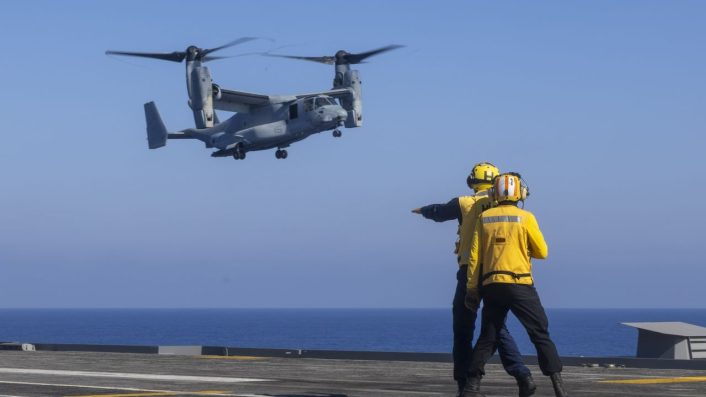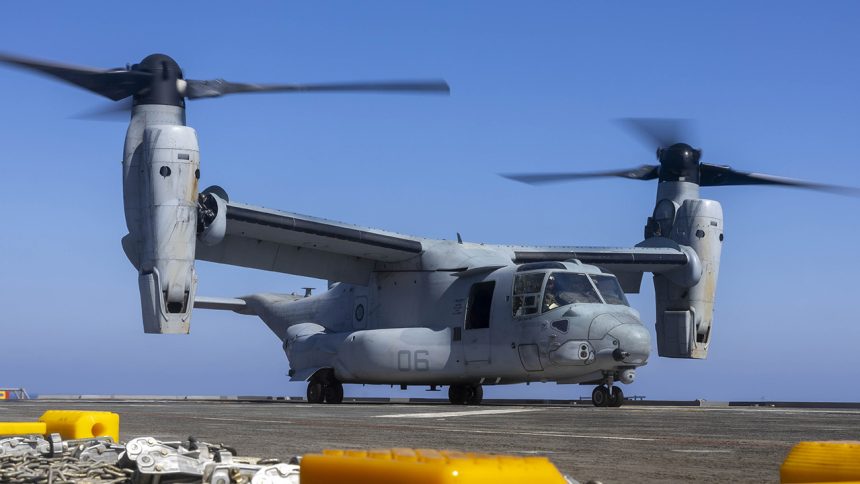Interestingly, Turkish reports identified the Osprey among one of the ‘NATO aircraft’ that can operate from the Anadolu since its elevators were designed for the purpose.
A U.S. Marine Corps MV-22B Osprey landed on Turkish amphibious assault ship TCG Anadolu on Aug. 15, 2024, the U.S. military revealed on Aug. 26. The operation was part of “bilateral exercises” between the Turkish Navy and the NAVEUR-NAVAF (U.S. Naval Forces-Africa) in the Mediterranean Sea. Held between Aug. 13 to Aug. 17 as per Turkish reports, the drills come against the backdrop of the ongoing crisis in the middle east.
However, such a landing, especially of the distinctive tilt-rotor Osprey, has not been reported before on the Turkish warship, which has been designated as a dedicated drone carrier.
A video showed the Osprey coming into land sideways on the Anadolu, before it was fastened onto the deck. The tilt-rotor helicopter took off after that. Turkish sailors and crews were also instructed by Aviation Boatswain Mates from the USS Wasp on how to “direct” and “chock and chain” the MV-22B after it landed.
The Osprey from VMM 365 (Marine Medium Tiltrotor Squadron 365) was operating from the American amphibious ship USS Wasp sailing in formation with the TCG Anadolu, the transport loading dock ship USS Oak Hill and the Turkish frigate TCG Gokova a day prior.
Akdeniz’de amfibi hücum gemisi USS Wasp (LHD-1) ve TCG Anadolu’nun gerçekleştirdiği ortak tatbikat sırasında Anadolu’ya iniş yapan, USMC’nin “Blue Knights” filosuna ait MV-22B Osprey. pic.twitter.com/9I3S787sCj
— BATTLESHIP LOVER (@Yamato_Armada) August 24, 2024
Anadolu designed to operate the Osprey
Interestingly, TurDef identified the Osprey among one of the “NATO aircraft,” that can operate from the Anadolu in a September 2022 report that covered the ship’s sea trials. This is because of the dimensions of the bow-side elevators that are designed to accommodate NATO aircraft. The others included the F-35B CH-53, CH-47, S-70B and AW149. “[These aircraft would be] able to take-off and land on the TCG Anadolu, which is designed and built to participate in NATO missions.”
It is also interesting to see the Osprey flying under the reported “restricted” envelope after the Nov. 29, 2023 crash of the U.S. Air Force CV-22 that killed eight airmen. As a subsequent investigation later revealed, the mishap was owing to a “catastrophic failure” in one of the aircraft’s PRGBs (Prop Rotor Gearboxes).

Gaza-Israel conflict driving the exercises
The TCG Anadolu has conducted exercises with the U.S. Navy at least once in the past, coincidentally around the same time this year. This was on Aug. 21, 2023, when it sailed alongside the USS Gerald R. Ford aircraft carrier when the CSG (Carrier Strike Group) was in the East Mediterranean Sea “to enhance interoperability.”
Meanwhile, the NAVEUR-NAVAF deployment aims to support “U.S., Allied and partner interests in the region, including in the Eastern Mediterranean Sea, to continue promoting regional stability and deterring aggression.” On Jun. 27, the U.S. European Command again reported the USS Wasp had entered the Strait of Gibraltar in the Mediterranean Sea in support of the deployment.
“Headquartered in Naples, Italy, NAVEUR-NAVAF operates U.S. naval forces in the U.S. European Command and U.S. Africa Command areas of responsibility. U.S. 6th Fleet is permanently assigned to NAVEUR-NAVAF and employs maritime forces through the full spectrum of joint and naval operations,” EUCOM said.
TCG ANADOLU ve ABD gemileri eğitimde.
Türk Donanmasına ait TCG ANADOLU ve Gabya sınıfı TCG GÖKOVA fırkateyni, ABD Donanmasına ait USS Wasp LHD ve USS Oak Hill LSP gemileriyle ortak eğitimler icra etti. pic.twitter.com/igmYqROCoE
— MaviVatan.net (@mavivatannet) August 18, 2024
Part of broader exercises in the Mediterranean
Turkish media however said that this latest drill was “unannounced.” “The recent exercise with the US Navy, conducted from Aug. 13-17, was not announced by the Ministry of National Defense, unusually. Turkish media only covered it after the US amphibious assault ship USS Wasp announced it on social media,” said Yetkin Report.
While referring to MV-22B Osprey from the USS Wasp conducting “landing and takeoff drills on Anadolu’s deck,” it added that it is “unclear whether Turkish pilots performed similar helicopter drills on Wasp’s deck.” The Wasp and another amphibious vessel, the USS Bataan, had been deployed to the Mediterranean since late-June.
The ships were a part of the “deterrent” deployment against “potential Iranian or Hezbollah attacks on Israel.” Just before its exercise with Anadolu, Wasp was in Cyprus’s Limassol port on Aug. 8, the report added.
Akdeniz’de amfibi hücum gemisi USS Wasp (LHD-1) ve TCG Anadolu’nun gerçekleştirdiği ortak tatbikat sırasında Anadolu’ya iniş yapan, USMC’nin “Blue Knights” filosuna ait MV-22B Osprey. pic.twitter.com/9I3S787sCj
— BATTLESHIP LOVER (@Yamato_Armada) August 24, 2024
On Aug. 24, satellite images showed the USS Wasp about 170 km west of Cyprus. The USS Bataan meanwhile had docked at Greece’s Souda Naval Base on Crete in February, Yetkin says. The USS Wasp and the Eisenhower have been spotted in the Mediterranean since early in June.
TCG Anadolu
The TCG Anadolu is the largest warship in the Turkish fleet, its flagship and also the world’s “first” vessel with an air wing mainly consisting of unmanned aircraft, according to Daily Sabah. Based on Spain’s flagship, the Juan Carlos I, the Anadolu is a LHD type amphibious assault ship. It is 231-meters (758-feet) long, 32-meters wide with a displacement of 27,436-tons. It has a top speed of around 21 knots, a range of 9,000 nautical miles, and can operate at sea for 50 days.
TCG #ANADOLU: The world’s first #UAV ship and #Türkiye’s largest warship.
Almost ready to be commissioned. pic.twitter.com/KlLEvcbw3c
— Clash Report (@clashreport) January 2, 2023
The ship was ordered in 2015, laid down in February 2018, launched in April 2019, and commissioned in April 2023. It is intended to undertake “sustaining long-endurance, long-distance military combat, or humanitarian relief operations while acting as a command center and flagship for the Turkish Navy.” Beside the TB3, it is also expected to also operate the Kizilelma, another one of Baykar’s unmanned combat aerial vehicles (UCAV).









